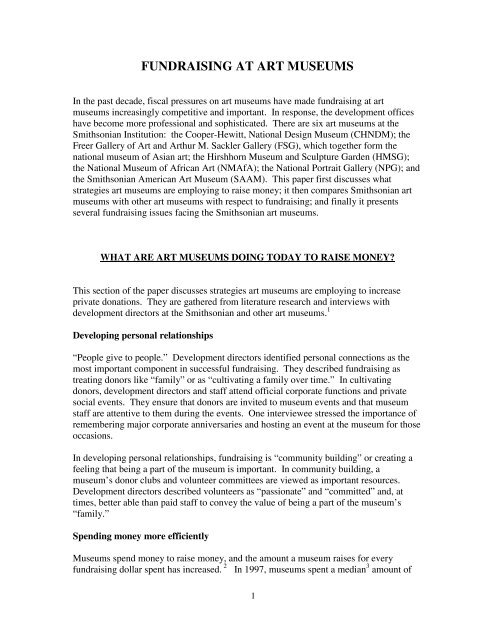Fundraising at Art Museums - Smithsonian Institution
Fundraising at Art Museums - Smithsonian Institution
Fundraising at Art Museums - Smithsonian Institution
Create successful ePaper yourself
Turn your PDF publications into a flip-book with our unique Google optimized e-Paper software.
FUNDRAISING AT ART MUSEUMS<br />
In the past decade, fiscal pressures on art museums have made fundraising <strong>at</strong> art<br />
museums increasingly competitive and important. In response, the development offices<br />
have become more professional and sophistic<strong>at</strong>ed. There are six art museums <strong>at</strong> the<br />
<strong>Smithsonian</strong> <strong>Institution</strong>: the Cooper-Hewitt, N<strong>at</strong>ional Design Museum (CHNDM); the<br />
Freer Gallery of <strong>Art</strong> and <strong>Art</strong>hur M. Sackler Gallery (FSG), which together form the<br />
n<strong>at</strong>ional museum of Asian art; the Hirshhorn Museum and Sculpture Garden (HMSG);<br />
the N<strong>at</strong>ional Museum of African <strong>Art</strong> (NMAfA); the N<strong>at</strong>ional Portrait Gallery (NPG); and<br />
the <strong>Smithsonian</strong> American <strong>Art</strong> Museum (SAAM). This paper first discusses wh<strong>at</strong><br />
str<strong>at</strong>egies art museums are employing to raise money; it then compares <strong>Smithsonian</strong> art<br />
museums with other art museums with respect to fundraising; and finally it presents<br />
several fundraising issues facing the <strong>Smithsonian</strong> art museums.<br />
WHAT ARE ART MUSEUMS DOING TODAY TO RAISE MONEY?<br />
This section of the paper discusses str<strong>at</strong>egies art museums are employing to increase<br />
priv<strong>at</strong>e don<strong>at</strong>ions. They are g<strong>at</strong>hered from liter<strong>at</strong>ure research and interviews with<br />
development directors <strong>at</strong> the <strong>Smithsonian</strong> and other art museums. 1<br />
Developing personal rel<strong>at</strong>ionships<br />
“People give to people.” Development directors identified personal connections as the<br />
most important component in successful fundraising. They described fundraising as<br />
tre<strong>at</strong>ing donors like “family” or as “cultiv<strong>at</strong>ing a family over time.” In cultiv<strong>at</strong>ing<br />
donors, development directors and staff <strong>at</strong>tend official corpor<strong>at</strong>e functions and priv<strong>at</strong>e<br />
social events. They ensure th<strong>at</strong> donors are invited to museum events and th<strong>at</strong> museum<br />
staff are <strong>at</strong>tentive to them during the events. One interviewee stressed the importance of<br />
remembering major corpor<strong>at</strong>e anniversaries and hosting an event <strong>at</strong> the museum for those<br />
occasions.<br />
In developing personal rel<strong>at</strong>ionships, fundraising is “community building” or cre<strong>at</strong>ing a<br />
feeling th<strong>at</strong> being a part of the museum is important. In community building, a<br />
museum’s donor clubs and volunteer committees are viewed as important resources.<br />
Development directors described volunteers as “passion<strong>at</strong>e” and “committed” and, <strong>at</strong><br />
times, better able than paid staff to convey the value of being a part of the museum’s<br />
“family.”<br />
Spending money more efficiently<br />
<strong>Museums</strong> spend money to raise money, and the amount a museum raises for every<br />
fundraising dollar spent has increased. 2 In 1997, museums spent a median 3 amount of<br />
1
















